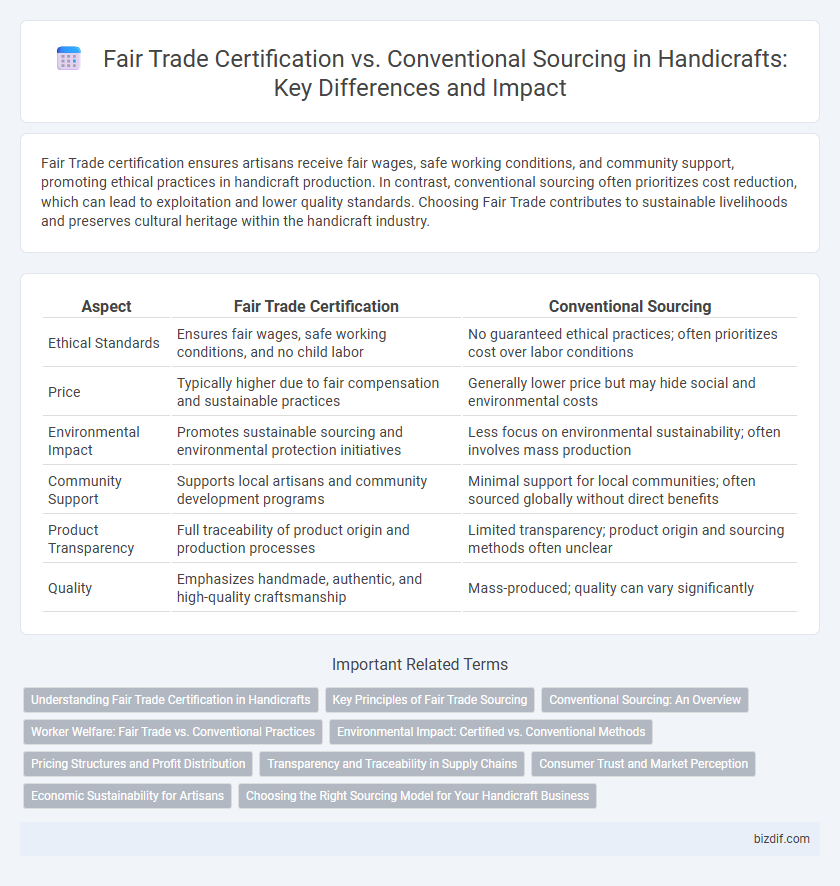Fair Trade certification ensures artisans receive fair wages, safe working conditions, and community support, promoting ethical practices in handicraft production. In contrast, conventional sourcing often prioritizes cost reduction, which can lead to exploitation and lower quality standards. Choosing Fair Trade contributes to sustainable livelihoods and preserves cultural heritage within the handicraft industry.
Table of Comparison
| Aspect | Fair Trade Certification | Conventional Sourcing |
|---|---|---|
| Ethical Standards | Ensures fair wages, safe working conditions, and no child labor | No guaranteed ethical practices; often prioritizes cost over labor conditions |
| Price | Typically higher due to fair compensation and sustainable practices | Generally lower price but may hide social and environmental costs |
| Environmental Impact | Promotes sustainable sourcing and environmental protection initiatives | Less focus on environmental sustainability; often involves mass production |
| Community Support | Supports local artisans and community development programs | Minimal support for local communities; often sourced globally without direct benefits |
| Product Transparency | Full traceability of product origin and production processes | Limited transparency; product origin and sourcing methods often unclear |
| Quality | Emphasizes handmade, authentic, and high-quality craftsmanship | Mass-produced; quality can vary significantly |
Understanding Fair Trade Certification in Handicrafts
Fair Trade certification in handicrafts ensures ethical production by promoting fair wages and safe working conditions for artisans, contrasting with conventional sourcing where such standards may be lacking. This certification supports sustainable community development and transparent supply chains, enhancing the social impact of each handcrafted product. By choosing Fair Trade handicrafts, consumers contribute to preserving traditional skills while empowering marginalized producers globally.
Key Principles of Fair Trade Sourcing
Fair Trade certification in handicraft emphasizes ethical sourcing by ensuring fair wages, safe working conditions, and community empowerment, contrasting with conventional sourcing that often prioritizes cost reduction over social impact. Key principles include transparency, direct trade relationships, and environmental sustainability, fostering long-term benefits for artisans and their communities. Fair Trade sourcing drives market access for marginalized producers, promoting equitable value distribution and cultural preservation.
Conventional Sourcing: An Overview
Conventional sourcing in handicraft involves traditional procurement methods where materials and products are acquired without specific sustainability or ethical standards, often prioritizing cost efficiency and volume. This approach can lead to challenges such as inconsistent quality, limited transparency, and potential exploitation within supply chains. Understanding conventional sourcing practices is essential for businesses aiming to balance cost and ethical considerations when comparing with Fair Trade certification.
Worker Welfare: Fair Trade vs. Conventional Practices
Fair Trade certification mandates rigorous standards ensuring fair wages, safe working conditions, and empowerment for artisans, contrasting sharply with conventional sourcing, which often overlooks these protections. Workers under Fair Trade benefit from collective bargaining and social premiums reinvested into community development, enhancing overall welfare. Conventional practices frequently result in exploitative labor environments, lacking transparency and accountability in artisan treatment.
Environmental Impact: Certified vs. Conventional Methods
Fair Trade certification promotes eco-friendly practices by enforcing strict environmental standards such as reduced chemical use, sustainable harvesting, and waste management in handicraft production. Conventional sourcing often relies on resource-intensive methods that can lead to soil degradation, water pollution, and higher carbon emissions. Choosing Fair Trade certified handicrafts supports lower environmental footprints and contributes to biodiversity conservation.
Pricing Structures and Profit Distribution
Fair Trade certification establishes transparent pricing structures that guarantee artisans a minimum price, often above market rates, ensuring sustainable incomes and stable profit distribution among producers. Conventional sourcing typically prioritizes lower costs, resulting in fluctuating artisan earnings and uneven profit distribution favoring intermediaries. Fair Trade models promote equitable profit sharing, empowering communities and supporting ethical handicraft production.
Transparency and Traceability in Supply Chains
Fair Trade certification ensures transparency and traceability by mandating rigorous documentation and regular audits throughout the handicraft supply chain, which conventional sourcing often lacks. The certification requires clear disclosure of labor practices, material origins, and payment structures, fostering ethical production and consumer trust. In contrast, conventional sourcing frequently suffers from opaque processes that obscure the origins of raw materials and the conditions faced by artisans.
Consumer Trust and Market Perception
Fair Trade certification enhances consumer trust by guaranteeing ethical sourcing and fair labor practices in handicraft production, distinguishing products from conventional sourcing methods that may lack transparency. Market perception strongly favors Fair Trade goods, as they are associated with social responsibility, sustainability, and premium quality. This trust drives higher consumer willingness to pay, expanding market opportunities for certified handicraft artisans globally.
Economic Sustainability for Artisans
Fair Trade certification ensures artisans receive fair wages and stable income, improving long-term economic sustainability compared to conventional sourcing, which often involves low pay and inconsistent orders. By promoting transparent supply chains, Fair Trade empowers artisans to invest in their businesses and communities, fostering sustainable growth. Conventional sourcing prioritizes cost-cutting, frequently resulting in exploitation and economic vulnerability among handicraft producers.
Choosing the Right Sourcing Model for Your Handicraft Business
Fair Trade certification ensures ethical sourcing by guaranteeing fair wages and safe working conditions, which enhances brand reputation and consumer trust in handicraft businesses. Conventional sourcing often prioritizes cost-efficiency but may involve exploitative labor practices, risking ethical concerns and negative publicity. Selecting the right sourcing model depends on your brand values, target market, and long-term sustainability goals, with Fair Trade providing a competitive advantage in socially conscious markets.
Fair Trade certification vs Conventional sourcing Infographic

 bizdif.com
bizdif.com